Date: August 6, 2020
Place: Emigrant Wilderness, Stanislaus National Forest, California
Coordinates: 38.179928, -119.688118
Length: 6.3 miles
Place: Emigrant Wilderness, Stanislaus National Forest, California
Coordinates: 38.179928, -119.688118
Length: 6.3 miles
Level: strenuous
On the morning of our 4th Emigrant Escape day I took my time, getting out of the tent only after the sun came out. My friend was still sleeping so I went down to the lake to enjoy the peaceful morning and the bird songs. The lake itself was very quiet, save for a few mergansers swimming near the center. As I approached the shore they got startled and flew off. I snapped a few quick shots and although the camera's setting wasn't suitable for the early morning illumination, I like the image that it produced.
 |
| Merganser |
My friend joined me by the lake shore. She brought the folding bucket to fill up some water. Then we stood by the lake and enjoyed the calm and beauty of Emigrant Lake for some time, before heading back to our campsite to make breakfast and to break camp.
 |
| Emigrant Lake |
Both of us felt invigorated and in high spirits. After a short discussion we decided to go on the longer route that would eventually lead us to Kennedy Lake. We agreed to take it easy that day too, stopping at the High Emigrant Lake for the night. Following the official trail it would be a near 10 miles mostly uphill walk, but looking at the map I could see a potential off-trail shortcut that seemed totally doable. Of course, I didn't know why, if it was an easy shortcut, wasn't there a trail to begin with. We would have to be there and see.
After a relatively late start, we were on our way, waving goodbye to the pretty granite dome that we had spent the night under.
The meadow extended beyond the east end of the lake and we followed the thin path through the vegetation. A few small birds hopped in the grass searching for their own breakfast, and among them there was a red headed one - a finch. My camera lens doesn't have the strong birding zoom that Pappa Quail has, but I tried my best to capture that bird. Thankfully, it collaborated.
 |
| Cassin's Finch |
The trail took us close to Emigrant Creek where I saw another bird, a shore bird this time, wandering along the bank. At home I got an identification of that bird from my family borders - it was a spotted sandpiper, of the same species we saw earlier that summer at Emerson Lake, at the heights of the South Warner Wilderness. I guess they prefer the relative isolation of the mountains over the busy ocean beach.
 |
| Spotted Sandpiper |
Following the creek eastward we were heading to the edge of the granite basin over which I knew, was the next lake on our route. Hard as I tried, I couldn't yet see the trail leading to the pass itself. We would have to cross the creek before that, according to the map.
Meanwhile, we had a refreshingly level walk by the creek side, enjoying the colorful wildflowers along the way.
We didn't reach the basin's edge. The trail curved south and crossed the creek at an almost dry spot. From there we ascended a mild slope along a narrow rocky path that took us over a low pass and dropped back into the east bound direction.
The rocky path was nicely decorated with yellow Arnica shrubs
The first lake on our way wasn't much to look upon. I think it has a name but it didn't stay in my mind. We didn't stop at that little lake. There was a trail junction there and we turned left, continuing east bound to Middle Emigrant Lake.
In my map the trail was labeled ' unmaintained' but it seemed clear enough for us to follow. At first, at least.
Soon we caught u with Emigrant Creek again, and once more we needed to cross it. The crossing was much less obvious this time and our trail was lost. I mean, it wasn't that there was no trail al of a sudden, Instead, there were many more trails, sprouting to our right, all of them seemingly leading across the creek but most proved unsuitable.
Eventually we did find a path that took us to a convenient creek fording place and we walked across, me pausing briefly to take photos.
After crossing the trail became much fainter and harder to follow. For the most part however, it was pretty clear where we were supposed to go, so even if we did lose the actual trail at times, we would catch up with it before getting worried.
On one location though, the trail did vanish altogether and I had to do some pathfinding before we got back on track. I guess that's what they meant by 'unmaintained'.
All along this 'unmaintained' path there were great numbers of wildflowers, representing all colors of the visible spectrum, with extension into the ultraviolet wavelengths.
That we were constantly gaining altitude, albeit mildly, became more evident when for the first time on this trip I started seeing alpine wildflowers of the kind I've seen only at high elevations on previous trips.
 |
| Rockfringe (Epilobium obcordatum) |
There were wildflowers that I must have seen before too, but they also could have been new to me because they were so similar to many others. Perhaps one day I'll know to differentiate between the fleabane and the aster numerous species that grow uo in the mountains.
 |
| Fleabane, erigeron sp. |
As we were making our way up the trail the soil slowly diminished. We were now walking between cracked rocks and large boulders, with shallow, loose gravel soil in between. Cushions of wildflowers gave the entire place a look of a well-tended rock garden.
As expected, there were lots of butterflies flying about, most of them too active to model for my camera. Some did cooperate, however.
After some mild ascent we found ourselves walking along a narrow creek vale that path through which was overgrown with low shrubs, many of them in bloom. The path was not visible so we simply walked in the creek bed itself.
Little monkeyflowers dotted the greenery of the little creek. Below the vegetation, a narrow trickle of water run by our feet. It was a lovely spot indeed.
At the top of that narrow vale I turned around and looked back. It seemed that the nearest domes were fairly low. Far away on the horizon loomed peaks that looked much higher. These were already within Yosemite National Park - a destination of a different trip altogether.
Looking ahead I could see the Middle Emigrant Lake, nestled between the low granite domes and hiding behind a thicket of willows. The trail was completely invisible but there was no obstacle netween us and the lake so we just pushed through the clamps of willows in a direct route to the water.
In between the willows were patches of exposed gravel which didn't support much vegetation. Tiny plants dotted sporadically those gravel patches. Little dandelion-like flowers that looked like little suns on earth, very delicate and pretty.
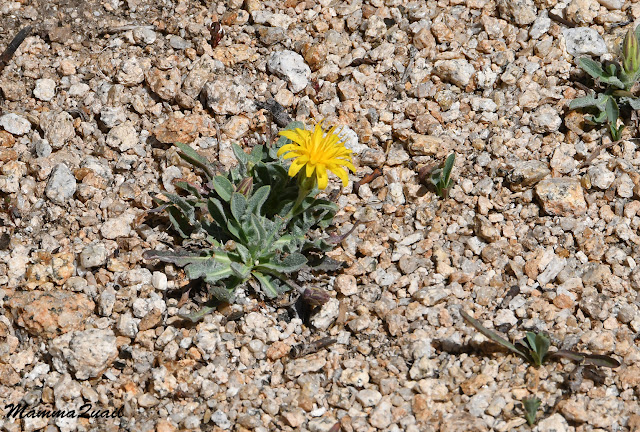 |
| Mountain Agoseris, Agoseris monticola |
The trees were also very sporadic here: bonsai-like, all wind-swept and twisted.
when we reached Middle Emigrant Lake we found that the thicket of willows belted it all around. We kept going along the path of least resistance until we found a convenient spot to stop for a lunch break. it had nice rocks to sit on and to spread our wet clothes from out morning wash to dry faster.
one thing that got me excited about that spot was that I found there Chaenactis plants in bloom - the first for this trip. This is another high altitude wildflower that I only get to see on my High Sierra trips.
 |
| Sierra Chaenactis, Chaenactis nevadensis |
After settling in that spot I pushed through the willows to the lake shore to get water. I spent some time looking around nd checking out the scenery there.
 |
| Middle Emigrant Lake |
We had a nice, long break by Middle Emigrant Lake. We had lunch, then my friend napped a bit while I explored the lake shore and filtered more water. Most of all, we enjoyed the solitude. This was the first day of our trip that ever since leaving the campsite, we didn't encounter any human soul. In this highly hiked wilderness, we found a precious area devoid of humans. It was very peaceful.
Eventually however, we did get up to go. Our plan was still getting to the High Emigrant Lake. All refreshed, we hoisted our packs and followed the very narrow path leading northeast.
The meadow we were walking through must have been dried fairly recently because the soil was still very moist. Had we come there a couple of weeks earlier, we might have had to plow our way through mud. As it was, the path was dry and the meadow green and dotted with wildflowers.
 |
| Lemmon's Paintbrush, Castilleja lemmonii |
At the end of the meadow we had to cross the creek again. Surprisingly wide and full, we had explored its bank to find a place for dry crossing. The path we were following had vanished in the vegetation and we had to bushwhack a bit to get to the water.
There were trout in this creek as well. The happiest trout we've seen so far on this trip - they were not confined to small water holes yet, and there were no humans with rods anywhere in the area.
After crossing the creek we were once again in a drier, gravelly area. It was the richest in wildflowers we had seen as of yet, but dominated by three or four species only. It was lovely to see this area all alive with color. It's a very short growth season up at 9000' elevation, roughly the altitude we were at.
And we were going higher still. A mild slope, hardly noticeable grade, it was a fairly easy walk. The main challenge was following the trail, it being either invisible to having too many alternate possibilities. Only at short segments it was very clear where the actual trail was.
Soon we came upon the next lake on our day's itinerary - Emigrant Meadow Lake. The lake, blue and beautiful, was nestled in a low granite basin. Being it however, loomed a very different looking peak. It was the Big Sam volcano - the one we were expected to climb over if we were to go to Kennedy Lake.
 |
| Emigrant Meadow Lake |
We arrived at the trail intersection where we had to make the decision weather to go on the shorter Emigrant Lakes loop or to go on to High Emigrant Lake and from there to try and get to Kennedy Lake. Not talking about that yet, we stopped at the intersection and I went down to Emigrant Meadow Lake to get more water.
The lake shore was very muddy so I needed to walk some distance along the shore to find a suitable place to pull some clean water into the bottles. There were many critters in the water, I assume many of them were mosquito larvae, and I was grateful that their mothers weren't around to taste my blood.
On my way back to the trail intersection I glimpsed a quick movement on the ground and turned my attention to it - a cute little squirrel it was. I approached it carefully, snapping a shot with each step. When I got close enough for the squirrel to look worried, I arched my way slowly around the trail, to avoid scaring it away.
 |
| Belding Ground Squirrel |
The dominant wildflower in that area was the very familiar pussypaws. Its bright pink splashed all over the gravelly soil, but also filling the cracks in the rocks.
 |
| One-seeded Pussypaws, Calyptridium monospermum |
Geology isn't my strongest knowledge area but it s a very fascinating field. My eyes have learned to seek and identify interesting geological phenomena, other than simply pretty rocks. There, just off the north shore of Emigrant Meadow Lake I saw the contact line of the granite (left) with the volcanic (right) zones, both igneous rocks, formed under very different conditions.
 |
| Geological Contact |
Ny friend also had a good eye for geological sights. She called my attention to the 'crocodile' that was crawling up the big boulder that protruded from the lake side meadow.
As always,I was enthralled by the wildflowers that were blooming everywhere. Even those I was already familiar with I was happy to see again and again.
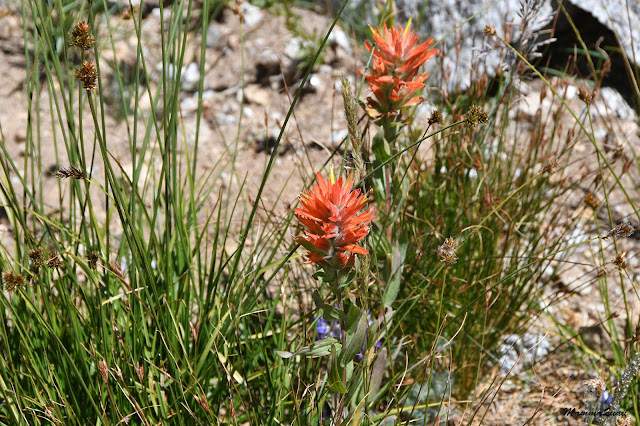 |
| Great Red Paintbrush, Castilleja miniata |
Somewhere between the Big Sam and where we stood was the High Emigrant Lake. It wasn't visible, but we knew it was there. The shortest route to that lake would be a short ascent off trail. On the map it looked totally doable. Looking directly at the slope we were expected to go cross-country on, we knew that it would be an easy short cut indeed.
As easy as this shortcut looked, I already knew it would take us a very long time to ascend, because there was a crazy bloom all the way up this pretty slope.
It would be a step - stop - photo all the way up. Most of these photos I had to leave out of this post otherwise it would have been way too heavy, but perhaps I'd add an accompaniment post to this, just for wildflowers photo gallery from this day.
 | |
| Parrothead Indian Paintbrush, Castilleja pilosa |
The most hindrance to our progress provided the lupine, which bloomed practically everywhere around me. I believe I photographed each and every lupine plant in my vicinity, about three of four times each.
Part way up I turned around and looked back at the way we had come, including the Emigrant Meadow Lake, which we had just left.
Of all the unique High Sierra flora it was amusing to see also the red flowers of the crimson columbine flowers, so common in the Bay Area, at sea level. I was hoping to see the Sierra columbine which I have seen on my second backpacking trip to Mineral King, but look as I might, I didn't see them on this trip.
 |
| Crimson Columbine, Aquilegia formosa |
Following the path of least resistance I made my way to the lip of the creek we were walking along, now deep below us. The water flowed merrily through a narrow crevice of black rock. Black wasn't the original color of these rocks but some sort of patina caused by exposure of the wetness and the air. Perhaps it was even some living algae of a sort. I don't know because we stayed up above the creek and didn't make it down to explore.
Even though we didn't walk for from the Emigrant Meadow Lake where we had stopped last, we did stay for another long break sitting perched on a rock over that little black creek. It was such a beautiful place! Not to mention al the pretty flowers blooming all around us.
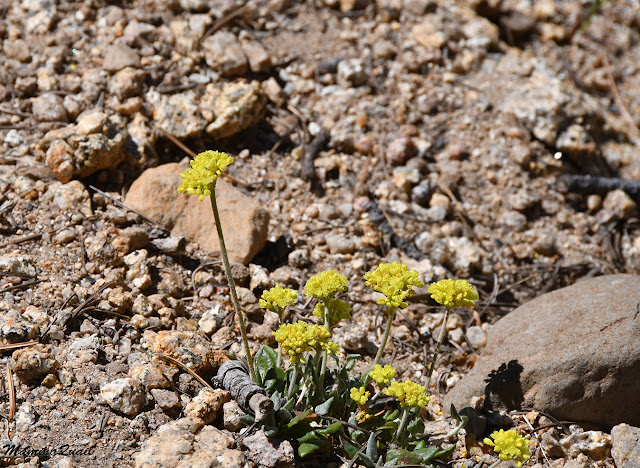 |
| Naked Buckwheat, Eriogonum nudum |
Right next to me there was another new sighting for this trip - the Sargent's campion. I like the delicate campion flowers and I was very glad to see a few of these plants at that spot.
 |
| Sargent's Campion, Silene sargentii |
My friend brought my attention to an overhanging rock across the creek. At its precarious pose, it looked like it would slide down in the next rainstorm.
I was more interested in the small, windswept pine trees further up the slope. As on cue, we got up, hoisted our backpacks, and continued up the slope.
We were very close now. Just a few steps more up hill and the High Emigrant Lake came into view, like a blue jewel under the very blue sky. North of the lake loomed the Big Sam. I looked at it but didn't say anything to my friend just yet. We connected with the trail that came from south, the one we would have had to take if the shortcut wouldn't have been passable, and headed directly to the lake.
 |
| High Emigrant Lake |
The short distance to the lake also proved to be very prolific in terms of wildflowers. I felt lightheaded, and not because of the altitude. Finally I reached the spiritual place that I was seeking - the feeling that only the high mountains can give, of being on the top of the world, a place still pure and untarnished by the human masses.
It's not that the place was completely virgin land. The lake itself was raised by a small stone dam, a structure that was already reclaimed by the local vegetation.
The lake wasn't full to the brim. The creek trickled from between the stones in the middle of the dam. Below the dam the soil was very moist, with many tiny monkeyflowers dotting the dark volcanic soil.
 |
| Primrose Monkeflower, Erythranthe primuloides |
Now was the time to look for a good camp site for the night. One challenge that we faced was the wind that all of a sudden had picked up to a very unpleasant intensity. At the northeast side of the lake I spotted a protrusion of rocks and I suggested we'd go there, hoping to find a shelter from the wind.
Coming upon a small, dry creek on our left I noticed it was flowing not with water, but with whitehead flowers. A fluffy-looking white stream of beauty.
 |
| Grayswamp Whiteheads, Angelica capitellata |
When we arrived at the rocks northeast of the lake I told my friend to wait for me while I looked around to search for a suitable campsite. I dropped my backpack next to her and I went circling around the butte.
 |
| Rajaa napping under the rocks |
East of the rock protrusion I saw a place that was suitable. Moreover, it was clear that people had camped there before. We wouldn't be breaking new ground there, which was definitely preferable. Besides, there were two ravens perched on the rock right by where I thought would be a good tent placement. I took that as a good omen. Ravens symbol one of the best Native American guardian spirits.
 |
| Ravens |
East of our rocky throne there was a flat meadow covered in bloom with mild hills flanking it from the east. The low hills of volcanic earth that bordered it on the east were wrinkled by small, narrow creeks. One of them looked like a dark-mouthed cave.
I completed circling the rock butte and lead my friend to its east side, where I thought of setting up camp. The location wasn't completely protected so we fiddled with the tent for some time, trying to find the best orientation to have the least wind effect. After pitching our tend I went down to the lake to get water. Looking behind me, I saw the tent, a light green spot, nestled against the low dome of rock. It felt good to be there, finally feeling the magic of the High Sierra working its way in my soul.
The lake shore was very muddy, and the water very shallow. In fact, it was very difficult to gather water without a cloud of particles streaming into the bottle as well. I had to take off my shoes and wade into the lake, very slowly and carefully as to not stir the muddy bottom. At knee high depth I could dip the bottle's lip below the surface and collect water of acceptable clarity.
The lake shore featured footprints of other, non human lake visitors. I recognized raccoon footprints and many bird tracks as well.
On the way back to the campsite I tackled a white object standing out in the vegetation. It was the skull of a buck. A young buck, if to judge by the two prongs of its still attached antlers. I called my friend to admire the relic as well. The photo of this poor buck's skull heads this blogpost. I think that Georgia O'Keeffe would have approved.
It was fairly early still so we went to explore the hills to the east and the gorgeous wildflowers that that bloomed there.
As expected at this high altitude, most of the wildflowers were very low, close to the ground. Typical of harsh growth conditions. From afar, I could identify the lupines and penstemons which dominated the meadow. As we got closer I could see more blooming species, including some that I was seeing for the first time on this trip.
 |
| Carpet Clover, Trifolium monanthum |
There were also flower species that I've seen for the first time altogether. Lifers.
 |
| Twincrest Onion, Allium biseptrum |
We had a lovely time exploring the meadow and the low sloped hills. Many of the photos I took there ended up cropped from this post because they would have made it way too long.
 |
| Dinnerplate Thistle, Cirsium scariosum var. americanum |
Still, many of the wildflowers had to be included here, this being the best wildflowers day I've had on that entire trip. Those photos will be posted on a wildflowers gallery posy that will be published in a couple of days from now.
 |
| Lewis' Flax, Linum lewisii |
We arrived at the dark spot that looked from a distance like the opening of a cave and we found no cave there whatsoever. Instead, we found there a cute little spring of fresh water. We both indulged in drinking fresh water directly from the source, not worrying about any contamination.
The spring, and the little brooke it fed, were a great wetland flowers bed. I followed the narrow trickle of water, each step revealing new botanic discoveries.
 |
| Sierra Spring Beauty, Claytonia nevadensis |
As we meandered along the edge of the meadow we suddenly heard vices carrying in the wind. Straining my eyes I could see three dots moving along the trail on the other side of the lake, coming from the south, the same direction we had arrived from. I felt bummed. All of a sudden we were no longer alone in the wilderness.
 |
| Yellow Monkeyflower, Erythranthe guttata |
It was too late in the day to hope that the newcomers would continue on. All I hoped was that they would want their solitude as well and won't camp anywhere close to where we were. Thankfully, they had settled west of the trail, on the west side of the lake. They did see us however, and as they pointed I waved to them and they waved back. That was the last of our interaction with the other hikers.
 |
| Dwarf Indian Paintbrush, Castilleja nana |
We started roaming back in the direction of our campsite. There were two options left for dinner and we debated which one to cook tonight and which to leave for tomorrow, now that we knew we would camp for a fifth night.
 |
| Chamisso Arnica, Arnica chamissonis |
When we were distant enough from the hills I looked over there again and saw a small patch of snow way in the back. When the last of it would melt, the spring would run dry, I thought. This summer was already on the drier side and the one to follow (now as I write these words) would be drier yet.
There was still plenty of daylight left when we were done with dinner. My friend wanted to go into the tent but once again I managed to convince her to join me for sunset viewing. Meanwhile I passed the time exploring the wildflowers near our tent.
 |
| Alpine Ivesia, Ivesia gordonii |
When the sun was low enough we walked to the west side of our rocky shelter and sat on a high platform to watch the sunset. The sun was sinking very slowly, giving us enough time to look at the local wildlife using the last hour of the day to forage. Other than the sphinx moth, we've also seen the crows again, and also another Belding ground squirrel. The moth was busy getting supper but the crows and the squirrel were simply enjoying the last rays of sun.
 |
| Sphinx Moth |
As the shadows lengthened the air became much chillier. The wind picked up even more, and we started shivering. To await the cold we stood up and started dancing on our rock platform. I thought to myself that if the backpackers on the other side of the lake were watching us, they were getting quite a show, but I didn't really care. I didn't see them outside of their tents anyway. Perhaps they went to bed early. What I did see was a ring of vegetation on the opposite shore, enclosing a circle of water. I might have been nice to go dippier g in there, but it was already too late for that.
As soon as the sun touched the horizon my friend bade me goodnight and disappeared behind the rock dome. I stood there shivering alone for a little while longer, reveling in my quiet solitude and the beauty of the place we were camping at.
 |
| Sunset at the High Emigrant Lake |
When the last sun rays vanished I made my way slowly back to the campsite. Shivering are intensely now I tidied up the campsite area and made sure all of our gear was packed and secured from the wind and from any nosy wildlife. Without even turning my flashlight on I joined my friend inside the tent. That night I slept very well indeed. Finally, I was in my element.
 |
| Post Sunset at the Hugh Emigrant Lake |












































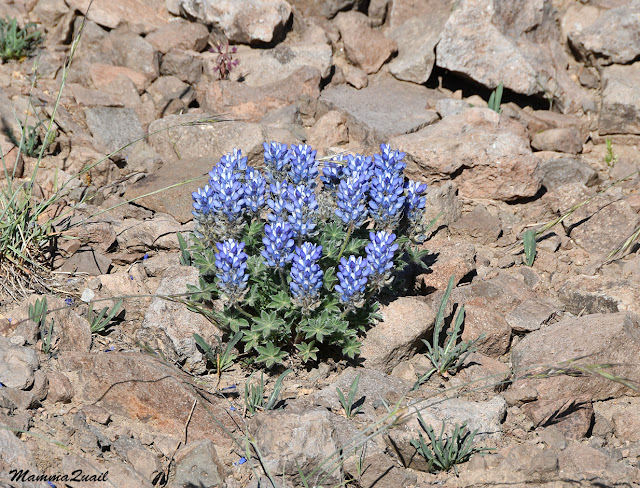
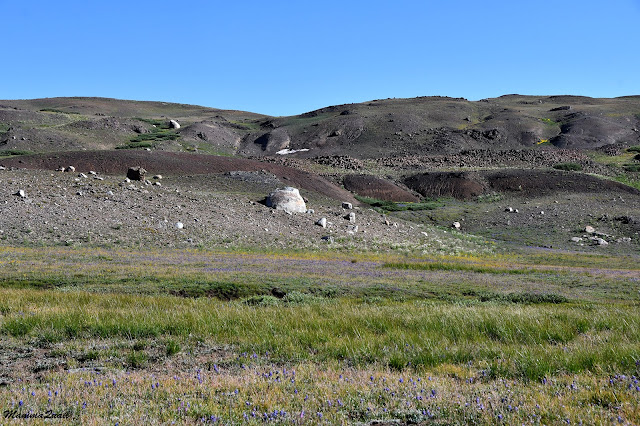



This trip was full of beautiful views and flowers. The first picture of the Merganser is great
ReplyDeleteThank you, my friend!
Delete